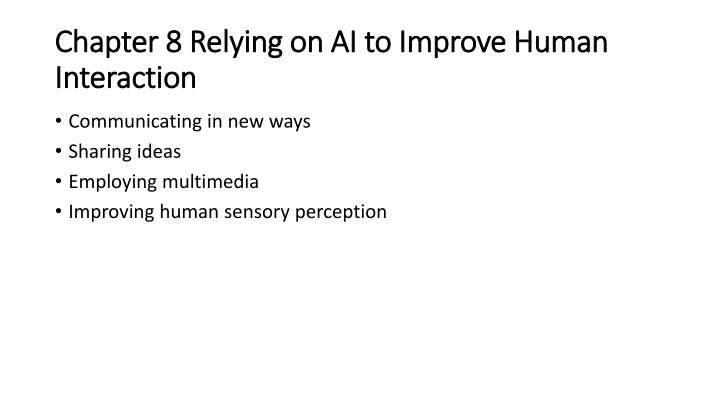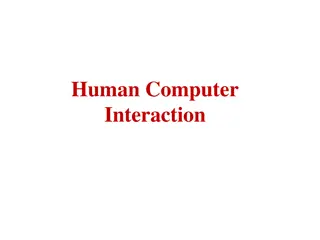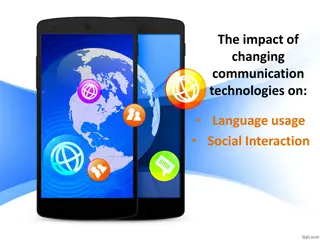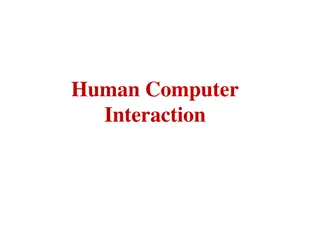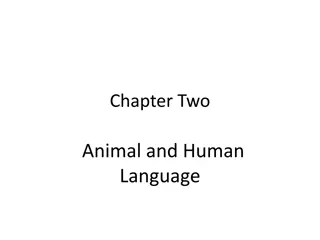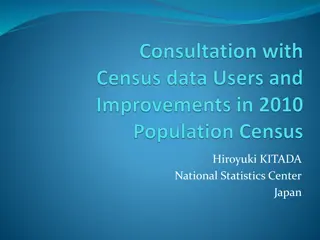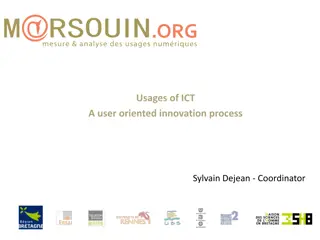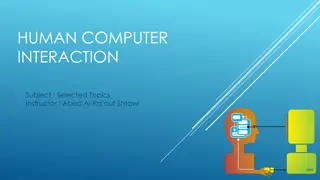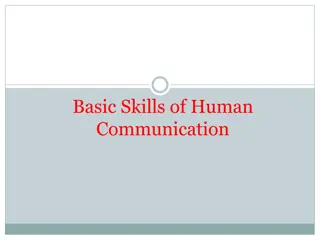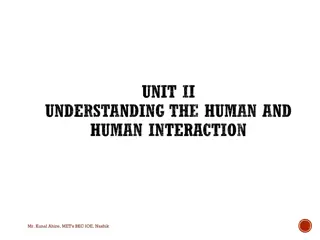Enhancing Human Interaction with AI: Communication Innovations
Exploring the role of AI in improving human interaction, this chapter delves into new ways of communicating, using multimedia, and enhancing sensory perception. From electronic noses to new alphabets like emoticons and emojis, AI is revolutionizing how we exchange ideas and express emotions.
Download Presentation

Please find below an Image/Link to download the presentation.
The content on the website is provided AS IS for your information and personal use only. It may not be sold, licensed, or shared on other websites without obtaining consent from the author.If you encounter any issues during the download, it is possible that the publisher has removed the file from their server.
You are allowed to download the files provided on this website for personal or commercial use, subject to the condition that they are used lawfully. All files are the property of their respective owners.
The content on the website is provided AS IS for your information and personal use only. It may not be sold, licensed, or shared on other websites without obtaining consent from the author.
E N D
Presentation Transcript
Chapter 8 Relying on AI to Improve Human Chapter 8 Relying on AI to Improve Human Interaction Interaction Communicating in new ways Sharing ideas Employing multimedia Improving human sensory perception
People interact with each other in myriad ways. Interaction can take many other forms, including eye contact, tonal quality, and even scent. An example of the computer version of enhanced human interaction is the electronic nose, which relies on a combination of electronics, biochemistry, and artificial intelligence to perform its task and has been applied to a wide range of industrial applications and research. In fact, the electronic nose can even sniff out diseases.
AI can also enhance the manner in which people exchange ideas. You can augment the power of multimedia, which is already substantial, by using AI. AI can give you almost superhuman sensory perception.
Developing New Ways to Communicate Developing New Ways to Communicate Communication involving a developed language initially took place between humans via the spoken versus written word. The three main methods of human nonverbal communication rely on Alphabets/Iconographs: The abstraction of components of human words or symbols Language: The stringing of words or symbols together to create sentences or convey ideas in written form Body language: The augmentation of language with context
Creating new alphabets The introduction to this section discusses two new alphabets used in the computer age: emoticons and emoji. For the most part, humans can interpret these iconic alphabets without too much trouble because they resemble facial expressions. An application doesn t have the human sense of art, so computers often require an AI just to figure out what emotion a human is trying to convey with the little pictures
Humans have created new alphabets to meet specific needs since the beginning of the written word. Emoticons and emojii represent two of many alphabets that you can count on humans creating as the result of the Internet and the use of AI.
Automating language translation The world has always had a problem with the lack of a common language. Having someone translate between languages can be expensive, cumbersome, and error prone, so translators, although necessary in many situations, aren t necessarily a great answer either. Google Neural Machine Translation (GNMT) system. It can actually look at entire sentences to make sense of them and provide better translations than applications that use phrases or words as the basis for creating a translation.
What is even more impressive is that GNMT can translate between languages even when it doesn t have a specific translator, using an artificial language, an interlingua. Say that the GNMT doesn t know how to translate between Chinese and Spanish. However, it can translate between Chinese and English and between English and Spanish.
Incorporating body language A significant part of human communication occurs with body language, which is why the use of emoticons and emojii is important. People are becoming more used to working directly with cameras to create videos and other forms of communication that involve no writing. A computer could possibly listen to human input, parse it into tokens representing the human speech, and then process those tokens to fulfill a request, similar to the manner in which Alexa or Google Home and their ilk work.
Unfortunately, merely translating the spoken word into tokens wont do the job because the whole issue of nonverbal communication remains. The computer camera must capture human positions to read the body language Posture Head motion Facial expression Eye contact Gestures
After an AI can read body language, it must also provide a means to output it when interacting with humans. Given that reading body language (facial expressions, body position, placement of hands, and so on) is in its infancy, robotic or graphic presentation of body language is even less developed. Robots can currently interpret body language and then react appropriately in some few cases.
Exchanging Ideas Exchanging Ideas An AI doesn t have ideas because it lacks both intrapersonal intelligence and the ability to understand. An AI can enable humans to exchange ideas in a manner that creates a whole that is greater than the sum of its parts. The humans involved in the process perform the exchange by relying on the AI to augment the communication process.
Creating connections A human can exchange ideas with another human, but only as long as the two humans know about each other. An AI can perform research based on the flow of ideas that a human provides and then create connections with other humans who have that same (or similar) flow of ideas. One of the ways in which this communication creation occurs is in social media sites such as LinkedIn.
Augmenting communication To exchange ideas successfully, two humans need to communicate well. AI could help communication between disparate groups in numerous ways. Language translation (assuming that the translation is accurate) is one of these methods. AI could also suggest aids like alternative graphics and so on to help communication take place in a manner that helps both parties.
Defining trends Humans often base ideas on trends. However, to visualize how the idea works, other parties in the exchange of ideas must also see those trends, and communicating using this sort of information is notoriously difficult. AI can perform various levels of data analysis and present the output graphically. Studies show that humans relate better to graphical output than tabular output, and graphical output will definitely make trends easier to see.
Using Multimedia Most people learn by using multiple senses and multiple approaches. Multimedia normally consists of sound, graphics, text, and animation, but some multimedia does more. AI can help with multimedia in numerous ways. One of the most important is in the creation, or authoring, of the multimedia.
Embellishing Human Sensory Perception Embellishing Human Sensory Perception One way that AI truly excels at improving human interaction is by augmenting humans in one of two ways: by allowing them to use their native senses to work with augmented data, or by augmenting the native senses to do more.
Shifting data spectrum When performing various kinds of information gathering, humans often employ technologies that filter or shift the data spectrum with regard to color, sound, touch, or smell. The human still uses native capabilities, but some technology changes the input such that it works with that native capability. The most intriguing technique for exploring our world, however, is completely different from what most people expect. What if you could smell a color or see a sound?
Augmenting human senses As an alternative to using an external application to shift data spectrum and somehow make that shifted data available for use by humans, you can augment human senses. In augmentation, a device, either external or implanted, enables a human to directly process sensory input in a new way. Physical augmentation of human senses already takes place in many ways, and it s guaranteed to increase as humans become more receptive to various kinds of implants. Intelligence Augmentation requires more intrusive measures but also promises to allow humans to exercise far greater capabilities.
